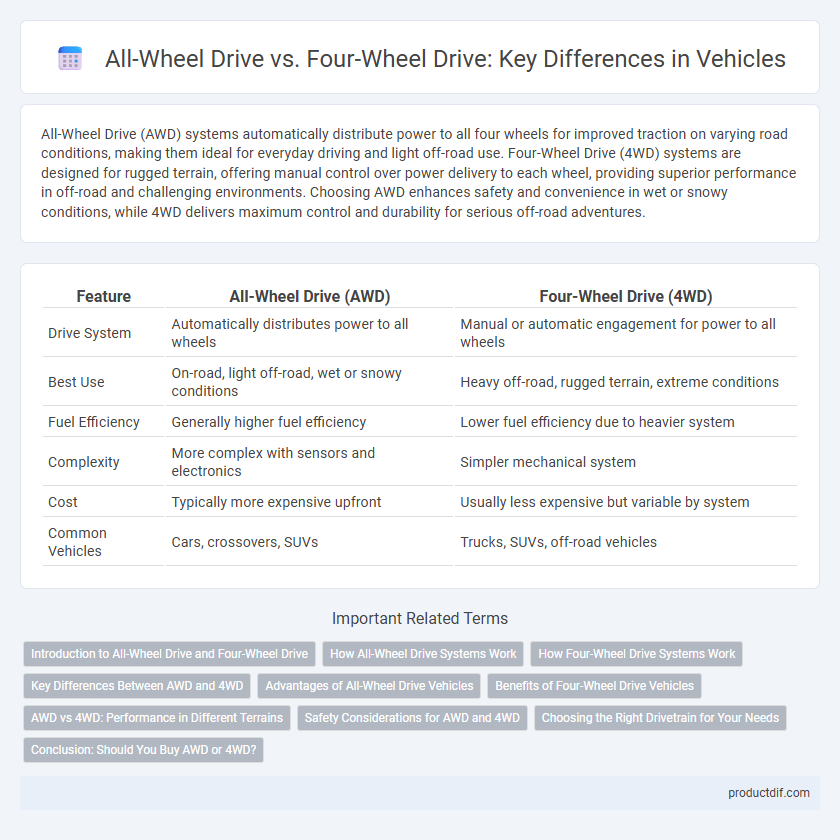All-Wheel Drive (AWD) systems automatically distribute power to all four wheels for improved traction on varying road conditions, making them ideal for everyday driving and light off-road use. Four-Wheel Drive (4WD) systems are designed for rugged terrain, offering manual control over power delivery to each wheel, providing superior performance in off-road and challenging environments. Choosing AWD enhances safety and convenience in wet or snowy conditions, while 4WD delivers maximum control and durability for serious off-road adventures.
Table of Comparison
| Feature | All-Wheel Drive (AWD) | Four-Wheel Drive (4WD) |
|---|---|---|
| Drive System | Automatically distributes power to all wheels | Manual or automatic engagement for power to all wheels |
| Best Use | On-road, light off-road, wet or snowy conditions | Heavy off-road, rugged terrain, extreme conditions |
| Fuel Efficiency | Generally higher fuel efficiency | Lower fuel efficiency due to heavier system |
| Complexity | More complex with sensors and electronics | Simpler mechanical system |
| Cost | Typically more expensive upfront | Usually less expensive but variable by system |
| Common Vehicles | Cars, crossovers, SUVs | Trucks, SUVs, off-road vehicles |
Introduction to All-Wheel Drive and Four-Wheel Drive
All-Wheel Drive (AWD) systems automatically distribute power to all four wheels, enhancing traction and stability on various road conditions including wet or slippery surfaces. Four-Wheel Drive (4WD) is typically designed for off-road and rugged terrain, allowing drivers to manually engage power to all wheels for improved control in challenging environments. Understanding the distinctions between AWD and 4WD is crucial for selecting the appropriate drivetrain based on driving needs and terrain types.
How All-Wheel Drive Systems Work
All-wheel drive (AWD) systems automatically distribute power to all four wheels, using a center differential or electronic clutch to adjust torque based on traction conditions. Sensors continuously monitor wheel slip, enabling the system to transfer power dynamically between front and rear axles for optimized grip on varying road surfaces. This seamless power distribution enhances vehicle stability and handling in adverse weather and on slippery terrain.
How Four-Wheel Drive Systems Work
Four-Wheel Drive (4WD) systems distribute power evenly to all four wheels simultaneously, enhancing traction on off-road and slippery surfaces. These systems typically include a transfer case that allows drivers to engage or disengage 4WD manually, optimizing performance for varying terrain conditions. Unlike All-Wheel Drive (AWD), 4WD often operates in low-range gearing, providing increased torque for challenging off-road maneuvers.
Key Differences Between AWD and 4WD
All-Wheel Drive (AWD) delivers power to all wheels continuously, optimizing traction on varied road conditions such as wet or snowy pavement, making it ideal for everyday driving and off-road light use. Four-Wheel Drive (4WD) typically operates in two-wheel drive mode and switches to four-wheel drive for enhanced traction in rugged off-road and challenging terrains, often featuring low-range gearing for extreme conditions. The fundamental difference lies in AWD's automatic power distribution for stability and 4WD's manual control designed for heavy-duty off-road performance.
Advantages of All-Wheel Drive Vehicles
All-wheel drive (AWD) vehicles provide enhanced traction and stability by continuously powering all four wheels, making them ideal for varying road conditions such as rain, snow, and light off-road terrain. The AWD system automatically adjusts torque distribution without driver input, improving handling and safety during unpredictable weather or slippery surfaces. Compared to traditional four-wheel drive (4WD) systems, AWD offers smoother on-road performance and better fuel efficiency by engaging all wheels only when necessary.
Benefits of Four-Wheel Drive Vehicles
Four-wheel drive (4WD) vehicles provide superior traction and control on rugged and off-road terrains due to their ability to distribute power evenly to all four wheels. They excel in challenging conditions such as snow, mud, and steep inclines, offering enhanced stability and safety compared to two-wheel or all-wheel-drive systems. The robust drivetrain and higher ground clearance of 4WD vehicles make them ideal for heavy-duty applications and demanding outdoor adventures.
AWD vs 4WD: Performance in Different Terrains
All-Wheel Drive (AWD) systems automatically distribute power to all four wheels for improved traction on varied road conditions, making them ideal for everyday driving and light off-road use. Four-Wheel Drive (4WD) systems provide driver-controlled engagement, delivering maximum torque to all wheels, which enhances performance in extreme off-road terrains like mud, snow, and rocky paths. AWD excels on wet or slippery paved roads by ensuring consistent grip, while 4WD is superior for rugged conditions where traction control and torque management are critical.
Safety Considerations for AWD and 4WD
All-Wheel Drive (AWD) systems enhance vehicle stability by automatically distributing power to all wheels, improving traction on slippery roads and reducing the risk of skidding. Four-Wheel Drive (4WD) offers superior off-road capability and control in extreme conditions by allowing the driver to manually engage power to all wheels, providing increased torque and better handling on rugged terrain. AWD is generally safer for everyday driving and variable weather, while 4WD excels in off-road safety and challenging environments requiring maximum traction.
Choosing the Right Drivetrain for Your Needs
All-Wheel Drive (AWD) offers seamless power distribution to all wheels, ideal for daily driving and varied road conditions, enhancing traction and stability. Four-Wheel Drive (4WD) provides manual control for power delivery, excelling in off-road, rugged terrains, and heavy-duty towing scenarios. Selecting the right drivetrain depends on your driving environment, with AWD suited for mixed weather and paved roads, while 4WD is preferable for serious off-roading and challenging landscapes.
Conclusion: Should You Buy AWD or 4WD?
All-Wheel Drive (AWD) suits drivers seeking seamless traction and stability on varied road conditions, ideal for daily commuting and light off-road use. Four-Wheel Drive (4WD) offers superior performance in extreme off-road environments and heavy-duty tasks, preferred by off-road enthusiasts and those requiring maximum torque distribution. Choosing between AWD and 4WD hinges on your driving needs, terrain challenges, and vehicle usage demands.
All-Wheel Drive vs Four-Wheel Drive Infographic

 productdif.com
productdif.com